QTZ40型塔式起重机进行总体设计及吊臂的设计
QTZ40塔式起重机——臂架优化设计
QTZ40塔式起重机的臂架优化设计【优秀机械毕业设计】
【word+13张CAD图纸全套】【带任务书+开题报告+实习报告】【94页@正文35700字】【详情如下】
A1拉板组.dwg
上弦杆.dwg
下弦杆.dwg
下接头(左).dwg
中文摘要.doc
任务书.doc
加强板.dwg
加强筋.dwg
吊点轴.dwg
吊臂总图.dwg
封皮.doc
开题报告.doc
开题报告封面.doc
支座板.dwg
目录.doc
第七节臂.dwg
第二节臂.dwg
英文摘要.doc
英文翻译
范艳东实习报告.doc
计算说明书.doc
轴套.dwg
销轴.dwg
毕业设计(论文)任务书
QTZ40塔式起重机——臂架优化设计
1、毕业设计(论文)目的:
毕业设计是对机械专业学生在毕业前的一次全面训练,目的在于巩固和扩大学生在校所学的基础知识和专业知识,训练学生综合运用所学知识分析和解决问题的能力。是培养、锻炼学生独立工作能力和创新精神之最佳手段。毕业设计要求每个学生在工作过程中,要独立思考,刻苦钻研,有所创新、解决相关技术问题。通过毕业设计,使学生掌握塔式起重机的总体设计、吊臂的设计、整体稳定性计算等内容,为今后步入社会、走上工作岗位打下良好的基础。
2、毕业设计(论文)任务内容和要求(包括原始数据、技术要求、工作要求等):
(1)设计任务:
①总体参数的选择(QTZ40级别)
②结构形式
(2)总体设计
①主要技术参数性能
②设计原则
③平衡重的计算
④塔机的风力计算
⑤整机倾翻稳定性的计算
(3)吊臂的设计和计算
①吊臂的形式及尺寸(变截面)(双吊点)
②吊臂的强度、稳定性及刚度验算
(4)设计要求
①主要任务:学生应在指导教师指导下独立完成一项给定的设计任务,编写符合要求的设计说明书,并正确绘制机械与电气工程图纸,独立撰写一份毕业论文,并绘制有关图表。
②知识要求:学生在毕业设计工作中,应综合运用多学科的理论、知识与技能,分析与解决工程问题。通过学习、钻研与实践,深化理论认识、扩展知识领域、延伸专业技能。
③能力培养要求:学生应学会依据技术课题任务,完成资料的调研、收集、加工与整理,正确使用工具书;培养学生掌握有关工程设计的程序、方法与技术规范,提高工程设计计算、图纸绘制、编写技术文件的能力;培养学生掌握实验、测试等科学研究的基本方法;锻炼学生分析与解决工程实际问题的能力。
④综合素质要求:通过毕业设计,学生应掌握正确的设计思想;培养学生严肃认真的科学态度和严谨求实的工作作风;在工程设计中,应能树立正确的生产观、经济观与全局观。
⑤设计成果要求:
凡给定的设计内容,包括说明书、计算书、图纸等必须完整,不得有未完的部分,不应出现缺页、少图纸现象。
1)对设计的全部内容,包括设计计算、机械构造、工作原理、整机布置等,均有清晰的了解。对设计过程、计算步骤有明确的概念,能用图纸完整的表达机械结构与工艺要求,有比较熟练的认识图纸能力。对运输、安装、使用等也有一定了解。
2)说明书、计算书内容要精练,表述要清楚,取材合理,取值合适,设计计算步骤正确,数学计算准确,各项说明要有依据,插图、表格及字迹均应工整、清楚、不得随意涂改。制图要符合机械机械制图标准,且清洁整齐。
3)对国内外塔式起重机情况有一般的了解,对各种塔式起重机有一定的分析、比较能力。
其他各项应符合本资料有关部分提出的要求。
3、毕业设计(论文)成果要求(包括图表、实物等硬件要求):
① 计算说明书一份
内容包括:设计任务要求的选型、设计计算内容、毕业实习报告等。作到内容完整,论证充分(包括经济性论证),字迹清楚,插图和表格正规(分别进行统一编号)、批准,字数要求不少于2万字;撰写中英文摘要;提倡学生应用计算机进行设计、计算与绘图。
② 图纸一套不少于四张零号图纸量。
4、主要参考文献:
[1] 哈尔滨建筑工程学院主编.工程起重机.北京:中国建筑工业出版社
[2] 董刚、李建功主编.机械设计.机械工业出版社
[3] 机械设计手册.化学工业出版社(5册)
[4] GB/T9462—1999 塔式起重机技术条件
[5] GB/T13752—1992 塔式起重机设计规范
[6] GB5144—1994 塔式起重机安全规程
[7] 邢静忠.ANSYS应用实例与分析.科学出版社.2006.
[8] 刘坤.ANSYS有限元方法精解.国防工业出版社.2005.
[9]GB/T9462—1999 塔式起重机设计条件.
[10] GB/T13752—1992 塔式起重机设计规范.
[11] GB/T5144—1994 塔式起重机安全规程
[12]刘鸿文.材料力学.北京:高等教育出版社.2002.
[13]李柱,徐振高.互换性与测量技术.北京:高等教育出版社.2002.
[14] 张东升.机械零件及建筑机械.重庆:重庆大学出版社.2003.
[15] 现行建筑机械规范大全.北京:中国建筑工业出版社.1995.
[16] 吴庆鸣,何小新.工程机械设计.武昌:武汉大学出版社.2006.
[17]刘佩衡.塔式起重机使用手册.北京:机械工业出版社.2002.
[18] 张质文,虞和谦等.起重机设计手册.北京:中国铁道出版社.1997.
[19] 顾迪民.工程起重机.北京:中国建筑工业出版社.1988.
[20] 王金诺,于兰峰.起重运输机金属结构.北京:中国铁道出版社.2002.
[21] 张凤山,董红光.塔式起重机构造与维修.北京:人民邮电出版社.2007.
[22] 张青.工程起重机结构与设计.化学工业出版社.2008.
5、本毕业设计(论文)课题工作进度计划:
起 迄 日 期 工 作 内 容
2013.3.25-2013.3.28
2013.3.29-2013.4.13
2013.4.14-2013.4.20
2013.4.21-2013.5.15
2013.5.16-2013.6.5
2013.6.6-2013.6.19
2013.6.20-2013.6.21
熟悉整理资料
方案选择及总体设计
绘制总图
臂架设计
绘制臂架装配及结构图纸
绘制零件图纸
准备论文及答辩
摘要
本次设计在参照同类塔式起重机基础上,对QTZ40型塔式起重机进行总体设计及吊臂的设计。在吊臂设计工程中,采用了有限元法对其进行分析计算,采用了ANSYS10.0软件进行分析。
按照整机主要性能参数,确定各机构类型及钢结构型式,主要确定了吊臂的结构参数,并按照吊臂端部加载、跨中加载及根部加载三种工况分析。通过对吊臂作适当的简化,应用ANSYS10.0软件建立吊臂有限元模型,施加各工况载荷,进行求解,进而可得各工况下各节点受力情况及各单元所受轴向力、轴向应力大小及各工况下吊臂的变形挠度大小,并能演示吊臂加载过程的动画,清晰的展现了各工况下吊臂的受力性能。
通过修改模型参数,对不同模型进行分析比较。由比较不同模型在相同工况下的受力状况及刚度状况,综合分析强度和刚度条件,可得出受力最为合理的一组模型参数,通过对此组参数下模型进行强度及刚度校核,进而获得吊臂的最终参数结果。
关键词:QTZ40型塔式起重机 吊臂 有限元分析 ANSYS10.0
Abstract
Refers to the similar tower crane, this design is composed by the system design and the lazy arm design to the QTZ40 tower crane. In the lazy arm design progress, it
has carried Finite Element method on the analysis computation, and used ANSYS10.0 software.According to the entire machine main performance parameter, various organizations type and the steel structure pattern has been determined. The design parameter of operating modes which are composed of nose increase, the cross center increase and the root increase. Through the suitable simplification to the lazy arm, the lazy arm finite element model is establishment applied ANSYS10.0 software, and then exerted various operating modes load, carried on the solution. Then ANSYS10.0 software can calculate various pitch points stress situation, various units receive the axial stress size, and the lazy arm distortion size under various operating modes. Also it can demonstrate the animation in the process of the lazy arm increase. It has clearly displayed the lazy arm stress performance under various operating modes.
Through the revision for model parameter, the analysis comparison is carried on the different model. Because the stress condition and rigidity condition of different
model is compared under the same operating mode, and the generalized analysis intensity and the rigidity condition is carried on, a most reasonable model parameter can be obtained, though the intensity and the rigidity examination regarding this model, then the final parameter result of the lazy arm can be obtained.
Key words: QTZ40 tower crane Lazy arm Finite element analysis ANSYS10.0
目 录
第1章 前言1
1.1 概述1
1.2 发展趋势1
第2章 总体设计2
2.1 概述2
2.2 确定总体设计方案2
2.3 总体设计原则29
2.4 平衡臂与平衡重的计算30
2.5 起重特性曲线32
2.6 塔机风力计算33
2.7 整机的抗倾覆稳定性计算43
2.8 固定基础稳定性计算49
第3章 吊臂的设计计算50
3.1 分析单吊点与双吊点的优缺点50
3.2 吊臂吊点位置选择51
3.3 吊臂结构参数参数52
3.4 有限元模型建立过程的几点简化53
3.5 吊臂结构的有限元分析计算54
3.6 计算结果分析69
3.7吊臂强度校核76
3.8 吊臂稳定性校核76
毕业设计小结87
致谢88
参考文献89
附:英文原文
英文翻译
毕业实习报告
第1章 前言
1.1 概述
塔式起重机是我们建筑机械的关键设备,在建筑施工中起着重要作用,我们只用了五十年时间走完了国外发达国家上百年塔机发展的路程,如今已达到发达国家九十年代末期水平并跻身于当代国际市场。QTZ40型塔式起重机简称QTZ40型塔机,是一种结构合理,性能比较优异的产品,比较国内同规格同类型的塔机具有更多的优点,能够满足高层建筑施工的需要,可用于建筑材料和预制构件的吊运和安装,并能在市内狭窄地区和丘陵地带建筑施工。高层建筑施工中,它的幅度利用率比其他类型起重机高,其幅度利用率可达全幅度的80%。
QTZ40型塔式起重机是400kN·m上回转自升式塔机。上回转自升塔式起重机是我国目前建筑工程中使用最广泛的塔机,几乎是万能塔机。它的最大特点是可以架得很高,所以所有的高层和超高层建筑、桥梁工程、电力工程,都可以用它去完成。这种塔式起重机适应性很强,所以市场需求很大。
1.2 发展趋势
塔式起重机是在第二次世界大战后才真正获得发展的。在六十年代,由于高层、超高层建筑的发展,广泛使用了内部爬升式和外部附着式塔式起重机。并在工作机构中采用了比较先进的技术,如可控硅调速、涡流制动器等。进入七十年代后,它的服务对象更为广泛。因此,幅度、起重量和起升高度均有了显著的提高。
就工程起重机而言,今后的发展主要表现在如下几个方面:①整机性能:由于先进技术和材料的应用,同种型号的产品,整机重量要轻20%左右;②高性能、高可靠性的配套件,选择余地大、适应性好,性能得到充分发挥;③电液比例控制系统和智能控制显示系统的推广应用;④操作更方便、舒适、安全,保护装置更加完善;⑤向吊重量大、起升高度、幅度更大的大吨位方向发展。
第2章 总体设计
2.1 概述
总体设计是毕业设计中至关重要的一个环节,它是后续设计的基础和框架。只有在做好总体设计的前提下,才能更好的完成设计。它是对满足塔机技术参数及形式的总的构想,总体设计的成败关系到塔机的经济技术指标,直接决定了塔机设计的成败。
总体设计指导各个部件和各个机构的设计进行,一般由总工程师负责设计。在接受设计任务以后,应进行深入细致的调查研究,收集国内外的同类机械的有关资料,了解当前的国内外塔机的使用、生产、设计和科研的情况,并进行分析比较,制定总的设计原则。设计原则应当保证所设计的机型达到国家有关标准的同时,力求结构合理,技术先进,经济性好,工艺简单,工作可靠。
2.2 确定总体设计方案
QTZ40塔式起重机是上回转液压自升式起重机。尽管其设计型号有各种各样,但其基本结构大体相同。整台的上回转塔机主要由金属结构,工作机构,液压顶升系统,电器控制系统及安全保护装置等五大部分组成。
2.2.1 金属结构
塔式起重机金属结构部分由塔顶,吊臂,平衡臂,上、下支座,塔身,转台等主要部件组成。对于特殊的塔式起重机,由于构造上的差异,个别部件也会有所增减。金属结构是塔式起重机的骨架,承受塔机的自重载荷及工作时的各种外载荷,是塔式起重机的重要组成部分,其重量通常约占整机重量的一半以上,因此金属结构设计合理与否对减轻起重机自重,提高起重性能,节约钢材以及提高起重机的可靠性等都有重要意义。
1. 塔顶
自升塔式起重机塔身向上延伸的顶端是塔顶,又称塔帽或塔尖。其功能是承受臂架拉绳及平衡臂拉绳传来的上部载荷,并通过回转塔架、转台、承座等的结构部件或直接通过转台传递给塔身结构。自升式塔机的塔顶有直立截锥柱式、前倾或后倾截锥柱式、人字架式及斜撑式等形式。截锥柱式塔尖实质上是一个转柱,由于构造上的一些原因,低部断面尺寸要比塔身断面尺寸为小,其主弦杆可视需要选用实心圆钢,厚壁无缝钢管或不等边角钢拼焊的矩形钢管。人字架式塔尖部件由一个平面型钢焊接桁架和两根定位系杆组成。而斜撑式塔尖则由一个平面型钢焊接桁架和两根定位系杆组成。这两种型式塔尖的共同特点是构造简单自重轻,加工容易,存放方便,拆卸运输便利。
塔顶高度与起重臂架承载能力有密切关系,一般取为臂架长度的1/7-1/10,长臂架应配用较高的塔尖。但是塔尖高度超过一定极限时,弦杆应力下降效果便不显著,过分加高塔尖高度不仅导致塔尖自重加大,而且会增加安装困难需要换用起重能力更大的辅助吊机。因此,设计时,应权衡各方面的条件选择适当的塔顶高度。
本设计采用前倾截锥柱式塔顶,断面尺寸为1.36m×1.36m。腹杆采用圆钢管。塔顶高6.115米。塔冒用无缝钢管焊接而成,顶部设有连接平衡臂拉杆和吊臂拉杆的铰销吊耳,以及穿绕起升钢丝绳的定滑轮,顶部应装有安全灯和避雷针。其结构如图2-1所示:
图2-1 塔顶结构图
2. 起重臂
1) 构造型式
塔式起重机的起重臂简称臂架或吊臂,按构造型式可分为:小车变幅水平臂架;俯仰变幅臂架,简称动臂;伸缩式小车变幅臂架;折曲式臂架。
小车变幅水平臂架,简称小车臂架,是一种承受压弯作用的水平臂架,是各式塔机广泛采用的一种吊臂。其优点是:吊臂可借助变幅小车沿臂架全长进行水平位移,并能平稳准确地进行安装就位。因此此次设计采用小车变幅水平臂架。
小车臂架可概分为三种不同型式:单吊点小车臂架,双吊点小车臂架和起重机与平衡臂架连成一体的锤头式小车臂架。单吊点小车变幅臂架是静定结构,而双吊点小车变幅臂架则是超静定结构。幅度在40m以下的小车臂架大都采用单吊点式构造;双吊点小车变幅臂架结构一般幅度都大于50m。双吊点小车变幅臂架结构自重轻,据分析与同等起重性能的单吊点小车变幅臂架相比,自重均可减轻5%-10%。小车变幅臂架拉索吊点可以设在下弦处,也可设在上弦处,现今通用小车变幅臂架多是上弦吊点,正三角形截面臂架。这种臂架的下弦杆上平面均用作小车运行轨道。
2) 分节问题
臂架型式的选定及构造细部处理取决于塔机作业特点,使用范围以及承载能力等因素,设计时,应通盘考虑作出最佳选择,首先要解决好分节问题。
小车臂架常用的标准节间长度有6、7、8、10、12m五种。为便于组合成若干不同长度的臂架,除标准节间外,一般都配设1~2个3~5m长的延接节,一个根部节,一个首部节和端头节。端头节构造应当简单轻巧,配有小车牵引绳换向滑轮、起升绳端头固定装置。此端头节长度不计入臂架总长,但可与任一标准节间配装,形成一个完整的起重臂。本次设计选用标准节长度为6m,另加上3.84m长的延接节。其示意图见图2-2:
图2-2臂架分节
3) 截面形式及截面尺度
塔机臂架的截面形式有三种:正三角形截面、倒三角形截面和矩形截面。小车变幅水平臂架大都采用正三角形截面,本次设计的QTZ40采用正三角形截面。选用这种方式的优点是:节省钢材,减轻重量,从而节约成本。其尺寸截面形式如图2-3所示:
图2-3 臂架截面及其腹杆布置
1-水平腹杆2-侧腹杆3-上弦杆4-下弦杆
臂架1-7节:B=1020mm H=800mm
臂架截面尺寸与臂架承载能力、臂架构造、塔顶高度及拉杆结构等因素有关。截面高度主要受最大起重量和拉杆吊点外悬臂长度影响最大。截面宽度主要与臂架全长有关。设计臂架长度为40m,共七节。
4) 腹杆布置和杆件材料选用
矩形截面臂架的腹杆体系宜采用人字式布置方式,而三角形截面起重臂的腹杆体系既可采用人字式布置方式,也可 采用顺斜置式。此两种布置方式各有特点。
当采用顺斜置式式,焊缝长度较短、质量不易保证。焊接变形不均匀,节点刚度较差,且不便于布置小车变幅机构。因此本设计选用人字式布置方式。其优点在于,这种布置方式应用区段不受限制,焊缝长度较长,强度易于保证,焊接变形较均匀,节点刚度较好,便于布置小车变幅机构。
臂架杆件材料有多种选择可能性。一般情况下,上吊点小车变幅臂架的上弦以选用Q345实心钢为宜,但造价要高。因此本设计选用20号无缝圆钢管。其特点是:惯性矩、长细比要小,抗失稳能力高。下弦采用等边角钢对焊的箱型截面杆件,经济实用,具有良好的抗压性能。因此上弦杆选用83×6、89×7、108×8,下弦选用的角钢型号为:63×5、70×6,臂间由销轴连接。
5) 吊点的选择与构造
吊点可分为单吊点和双吊点。其设计原则是:臂架长度小于50m,对最大起吊量并无特大要求,一般采用单吊点结构。若臂架总长在50m以上,或对跨中附近最大起吊量有特大要求应采用双吊点。采用单吊点结构时,吊点可以设在上弦或下弦。吊点以左可看作简支梁,以右可看作悬臂梁。在设计中采用双吊点。
3. 平衡臂与平衡重
QTZ40塔式起重机是上回转塔机。上回转塔机均需配设平衡臂,其功能是支撑平衡重(或称配重),用以构成设计上所需要的作用方向与起重力矩方向相反的平衡力矩,在小车变幅水平臂架自升式塔机中,平衡臂也是延伸了的转台,除平衡重外,还常在其尾端装设起升机构。起升机构之所以同平衡重一起安放在平衡臂尾端,一则可发挥部分配重作用,二则增大钢丝绳卷筒与塔尖导轮间的距离,以利钢丝绳的排绕并避免发生乱绳现象。
1) 平衡臂的结构型式
平衡臂的构造设计必须保证所要求的平衡力矩得到满足。短平衡臂的优点是:便于保证塔机在狭窄的空间里进行安装架设和拆卸,适合在城市建筑密集地区承担施工任务的塔机使用,不易受邻近建筑物的干扰,结构自重较轻。长平衡臂的主要优点是:可以适当减少平衡重的用量,相应减少塔身上部的垂直载荷。平衡重与平衡臂的长度成反比关系,而平衡臂长度与起重臂之间又存在一定关系,因此,平衡臂的合理设计可节约材料,降低整机造价。
常用平衡臂有以下三种结构型式:
(1) 平面框架式平衡臂,由两根槽钢纵梁或由槽钢焊成的箱形断面组合梁河系杆构成。在框架的上平面铺有走道板,走到板两旁设有防护栏杆。其特点是结构简单,加工容易。
(2) 三角形断面桁架式平臂,又分为正三角形断面和倒三角形断面两种形式。此类平衡臂的构造与平面框架式平衡臂结构构造相似,但较为轻巧,适用于长度较大的平衡臂。从实用上来看,正三角形断面桁架式平衡臂似不如倒三角形断面桁架式平衡臂。
(3) 矩形断面格桁结构平衡臂,其特点是根部与座在转台上的回转塔架联接成一体,适用于小车变幅水平臂架特长的超重型自升式塔机。
平衡臂结构选用型式的原则是:自重比较轻;加工制造简单,造型美观与起重臂匹配得体。故此次设计选用平面框架式平衡臂。它由两根槽钢纵梁或由槽钢焊成的箱形断面组合梁和系杆构成。在框架的上平面铺有走道板,走道板两旁设有防护栏杆。这种平衡臂的优点是结构简单,加工容易。平衡臂的长度是11.67m。如图2-4所示:
图2-4 平衡臂
2) 平衡重
平衡重属于平衡臂系统的组成部分,它的用量甚是可观,轻型塔机一般至少要用3~4t,重型自升式塔机要装有近30t平衡重。因此在设计平衡重过程中,应对平衡重的选材、构造以及安装进行认真考虑并作妥善安排。
平衡重一般可分为固定式和活动式两种。活动平衡重主要用于自升式塔机,其特点是可以移动,易于使塔身上部作用力矩处于平衡状态,便于进行顶升接高作业。但是,构造复杂,机加工量大,造价较高。故国内大部分塔机均采用固定式平衡重。
平衡重可用铸造或钢筋混凝土制成。铸铁平衡重的构造较复杂,制造难度大,加工费用贵,但体形尺寸较小,迎风面积较小,有利于减少风载荷的不利影响。钢筋混凝土平衡重的主要缺点是体积大,迎风面积大,对塔身结构及稳定性均有不利影响。但是构造简单,预制生产容易,可就地浇注,并且不怕风吹雨淋,便于推广。
因此,本次设计的塔式起重机采用钢筋混凝土式平衡重。
4. 拉杆
QTZ40塔式起重机采用双吊点式拉杆结构,拉杆由焊件组成,其材料为Q345,拉杆节之间用过渡节连接,由受力特性计算出其拉杆点作为位置,其中在平衡臂和吊臂上设有拉板和销轴用来连接用。
5. 上、下支座
上支座上部分别与塔顶、起重臂、平衡臂连接,下部用高强螺栓与回转支承相连接在支承座两侧安装有回转机构,它下面的小齿轮准确地与回转支承外齿圈啮合,另一面设有限位开关。
下支座上部用高强螺栓与回转支承连接、支承上部结构,下部四角平面用4个销轴和8个M30的高强螺栓分别与爬升架和塔身连接。
6. 塔身
塔身结构也称塔架,是塔机结构的主体,支撑着塔机上部结构的重量和承受载荷,并将这些载荷通过塔身传至底架或直接传递给地基基础。
1) 塔身结构断面型式
塔身结构断面分为圆形断面、三角形断面及方形断面三类。圆形断面和三角形断面现在基本上不用,现金国内外生产的塔机均采用方形断面结构。因此本设计采用的也是方形断面结构。按塔身结构主弦杆材料的不同,这类方形断面塔架可分为:角钢焊接格桁架结构塔身,主弦杆为角钢辅以加强筋的矩形断面格桁架结构;角钢拼焊方钢管格桁架结构塔身及无缝钢管焊接格桁架结构塔身。由型钢或钢管焊成的空间桁架,其成本比较低,且能满足工作需要。因此主弦杆采用由等边角钢拼焊成的方管。这种样式具有选材方便、灵活的优点。常用的矩形尺寸有:1.2m×1.2m,1.3m×1.3m,1.4m×1.4m,1.5m×1.5m,1.6m×1.6m,1.7m×1.7m,1.8m×1.8m,2.0m×2.0m。此次设计的尺寸为1.6m×1.6m。根据承载能力的不同,同一种截面尺寸,其主弦杆又有两种不同截面之分。主弦杆截面较大的标准节用于下部塔身,主弦杆截面较小的标准节则用于上部塔身。塔身标准节的长度有2.5m,3m,3.33m,4.5m,5m,6m,10m等多种规格,常用的尺寸是2.5m和3m。选用标准节长度为2.5m。
2) 塔身结构腹杆系统
塔身结构的腹杆系统采用角钢或无缝钢管制成,腹杆可焊装与角钢主弦杆内侧或焊装于角钢主弦杆外侧。斜腹杆和水平腹杆可采用同一规格,腹杆有三角形,K字型等多种布置形式。腹杆不同会影响塔身的扭转刚度和弹性稳定。
本次设计腹杆采用三角形布置。适合于中等起重能力塔身结构采用的腹杆布置方式。
3) 标准节间的联接方式
塔身标准节的联接方式有:盖板螺栓联接,套柱螺栓联接,承插销轴联接和瓦套法兰联接。盖板螺栓联接和套柱螺栓联接应用最广。
本次设计的QTZ40塔机采用套柱螺栓联接,其特点是:套柱采用企口定位,螺栓受拉,用低合金结构钢制作。适用于方钢管和角钢主弦杆塔身标准节的联接,虽加工工艺要求比较复杂,但安装速度比较快。
4) 塔身结构设计
(1) 轻、中型自升塔机和内爬式塔机宜采用整体式塔身标准节。附着式自升式塔机和起升高度大的轨道式以及独立式自升塔机宜采用拼装式塔身标准节。拼装式塔机塔身标准节的加工精度要求比较高,制作难度比较大,零件多和拼装麻烦,但拼装式塔身标准节的优越性更不容忽视:一是堆放储存占地小;二是装卸容易;三是运输费用便宜,特别是长途陆运和运洋海运,由于利用集装箱装运,其抗锈蚀和节约运费的效果极为显著。QTZ40属于中型自升式塔机,综合各种型式的特点,塔身结构采用整体式塔身标准节,如图2-5所示:
图2-5 塔身结构示意图
(2) 为减轻塔身的自重,充分发挥钢材的承载能力,并适应发展组合制式塔机的需要,对于达到40m起升高度的塔机塔身宜采用两种不同规格的塔身标准节,而起升高度达到60m的塔机塔身宜采用3种不同规格的塔身标准节。除伸缩式塔身结构和中央顶升式自升塔机的内塔外,塔身结构上、下的外形尺寸均保持不变,但下部塔身结构的主弦杆截面则须予以加大。
(3) 塔身的主弦杆可以是角钢、角钢拼焊方钢管、无缝钢管式实心圆钢,取决于塔身的起重能力、供货条件、经济效益以及开发系列产品的规划和需要。
(4) 塔身节内必须设置爬梯,以便司机及机工可以上下。在设计塔身标准节,特别是在设计拼装式塔身标准节时,要处理好爬梯与塔身的关系,以保证使用安全及安装便利。爬梯宽度不宜小于40mm,梯级间距应上下相等,并应不大于30mm。当爬梯高度大于5m时,应从高2m处开始装设直径为650~800mm的安全护圈,相邻两护圈间距为40mm.。当爬梯高度超过10m时,爬梯应分段转接,在转接处加一休息平台。
对于高档的塔机,可根据用户要求增设电梯,以节省司机的体力,充分体现人机工程学的应用。
5) 塔身的接高问题
在遇到塔身需要接高问题时,应按下述两种不同情况分别处理:
(1) 在额定最大自由高度范围内,根据工程对象需要增加塔身标准节,使低塔机变为高塔机。
(2) 根据施工需要,增加塔身标准节,使塔身高度略超越固定式塔机的规定最大自由高度。
在进行具体接高操作之前,还应制定相关的安全操作规程,以保证拆装作业的安全顺利进行。
7.转台装置
转台是一个直接坐在回转支承(转盘)上的承上启下的支撑结构。
上回转自升式塔机的转台多采用型钢和钢板组焊成的工字型断面环梁结构,它支撑着塔顶结构和回转塔架 ,并通过回转支承及承座将上部载荷下传给塔身结构。
8.回转支承装置
回转支承简称转盘,是塔式起重机的重要部件,由齿圈、座圈、滚动体、隔离快、连接螺栓及密封条等组成。按滚动体的不同,回转支承可分为两大类:一是球式回转支承,另一类是滚柱式回转支承。
1) 柱式回转支承
柱式回转支承又可分为:转柱式和定柱式两类。定柱式回转支承结构简单,制造方便,起重回转部分转动惯量小,自重和驱动功率小,能使起重机重心降低。转柱式结构简单,制造方便,适用于起升高度和工作幅度以及起重量较大的塔机。
2) 滚动轴承式回转支承
滚动轴承式回转支承装置按滚动体形状和排列方式可分为:单排四点角接触球式回转支承、双排球式回转支承、单排交叉滚柱式回转支承、三排滚柱式回转支承。滚动轴承式回转支承装置结构紧凑,可同时承受垂直力、水平力和倾覆力矩是目前应用最广的回转支承装置。为保证轴承装置正常工作,对固定轴承座圈的机架要求有足够的刚度。滚动轴承式回转支承,回转部分固定,在大轴承的回转座圈上,而大轴承的的固定座圈则与塔身(底架或门座)的顶面相固结。
设计选用球式回转支承,其优点是:刚性好,变形比较小,对承座结构要求较低。钢球为纯滚动,摩擦阻力小,功率损失小。
根据构造不同和滚动体使用数量的多少,回转支承又分为单排四点接触球式回转支承、双排球式回转支承、单排交叉滚柱式回转支承和三排滚柱式回转支承。
设计采用单排四点接触球式回转支承,它是由一个座圈和齿圈组成,结构紧凑,重量轻,钢球与圆弧滚道四点接触,能同时承受轴向力、径向力和倾翻力矩。
9.底架
塔机底架构造随着塔身结构特点(转柱式塔身或定柱式塔身),起重机的走形方式(轨道式、轮胎式或履带式)及爬升方式(内爬式或外附着自升式)而异。
小车变幅水平臂架自升塔机采用的底架结构可分为:十字型底架,带撑杆的十字型底架,带撑杆的井字型底架,带撑杆的水平框架式杆件拼装底架和塔身偏置式底架。
本次设计采用的是带撑杆的x底架。底架用工字钢焊接成框架结构,在四角安装有四条辐射状可拆卸支腿,该支腿用槽钢焊接而成,用螺栓与框架结构连接,底架通过20个预埋地脚螺栓与基础固定,螺栓为M36,底架外轮廓尺寸约为:长×宽×高=4600×4600×250 mm。
撑杆的作用是使塔身基础节与底架的四角相连,形成一个空间结构,增加塔机整体稳定性。由于塔身撑杆的设置,塔身危险断面由塔身根部向上移到撑杆的上支承面,同时塔身根部平面对底架的作用减小,从而改善底架的受力情况。
底架安装时,将底架拼装组合,放置于混凝土基础上,对正四角的放射形支腿地脚螺栓,使底架垫平牢实,要求校平,平面度小于1/1000,拧紧20个M36的地脚螺栓。
10. 附着装置
附着装置由一套附着框架,四套顶杆和三根撑杆组成,通过它们将起重机塔身的中间节段锚固在建筑物上,以增加塔身的刚度和整体稳定性.撑杆的长度可以调整,以满足塔身中心线到建筑物的距离限制.
塔身附着装置是用角钢对焊组合成的附着框架,由螺栓联接成框形,包箍于塔身标准的外表面,在附着框架下方的塔身主弦杆上分别固定一个小抱箍,以支持附着框架的重量,再由三根可伸缩调整的附着撑杆,通过销轴把该框架与建筑物连接,使塔机在规定高度与建筑物附着。.附着装置如图2-6所示:
参考文献
[1] 哈尔滨建筑工程学院主编.工程起重机.北京:中国建筑工业出版社
[2] 董刚、李建功主编.机械设计.机械工业出版社
[3] 成大先.机械设计手册.化学工业出版社(5册)
[4] GB/T9462—1999 塔式起重机技术条件
[5] GB/T13752—1992 塔式起重机设计规范
[6] GB5144—1994 塔式起重机安全规程
[7] 邢静忠.ANSYS应用实例与分析.科学出版社.2006.
[8] 刘坤.ANSYS有限元方法精解.国防工业出版社.2005.
[9] GB/5144—94 塔式起重机安全规程.
[10] JG/T1 5037—93 塔式起重机分类.
[11] 孙在鲁. 塔式起重机应用技术. 北京:中国建材工业出版社. 2003.
[12] 刘鸿文.材料力学.北京:高等教育出版社.2002.
[13] 李柱,徐振高.互换性与测量技术.北京:高等教育出版社.2002.
[14] 张东升.机械零件及建筑机械.重庆:重庆大学出版社.2003.
[15] 建设部北京建筑机械综合研究所中国标准出版社第三编辑室.北京:中国标准出版社.1998.
[16] 吴庆鸣,何小新.工程机械设计.武昌:武汉大学出版社.2006.
[17] 刘佩衡.塔式起重机使用手册.北京:机械工业出版社.2002.
[18] 张质文,虞和谦等.起重机设计手册.北京:中国铁道出版社.1997.
[19] 范俊祥.塔式起重机.北京:中国建材工业出版社.2004.
[20] 王金诺,于兰峰.起重运输机金属结构.北京:中国铁道出版社.2002.
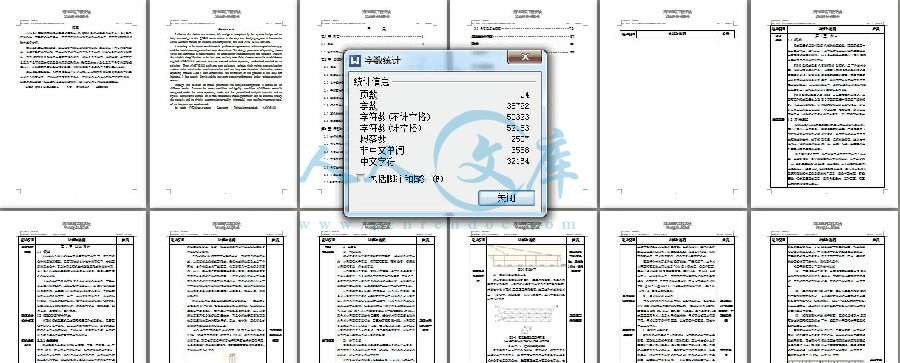





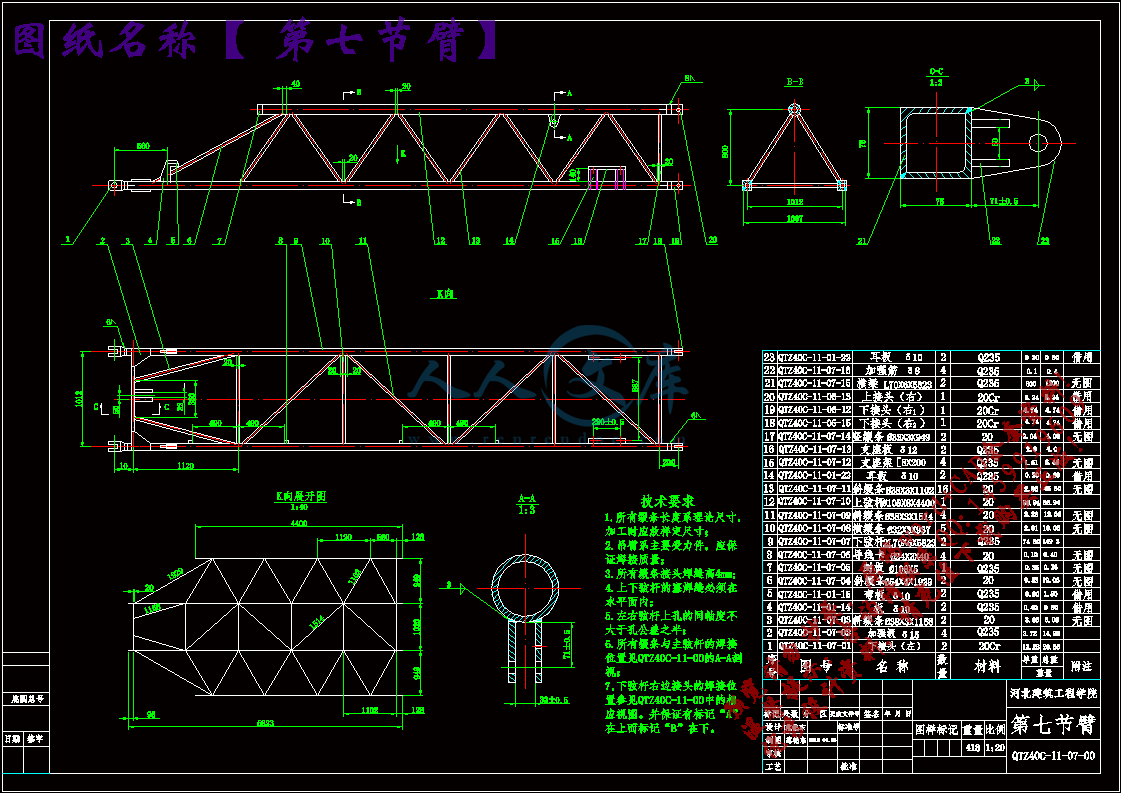

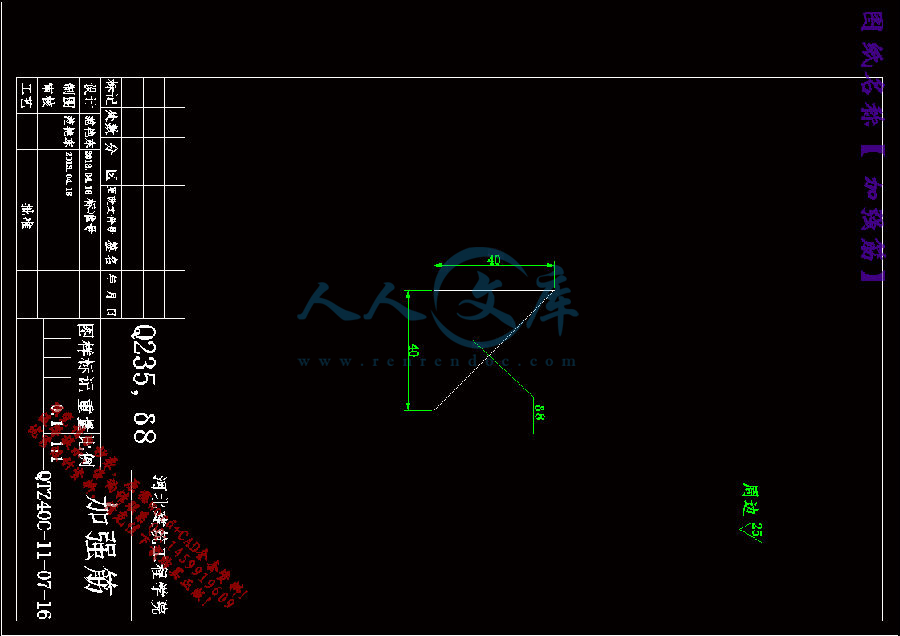
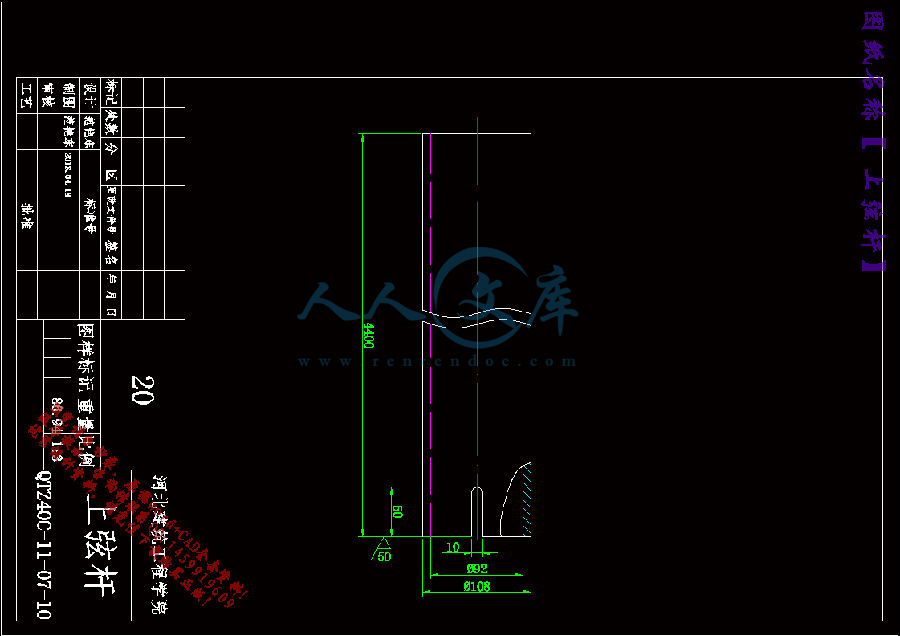



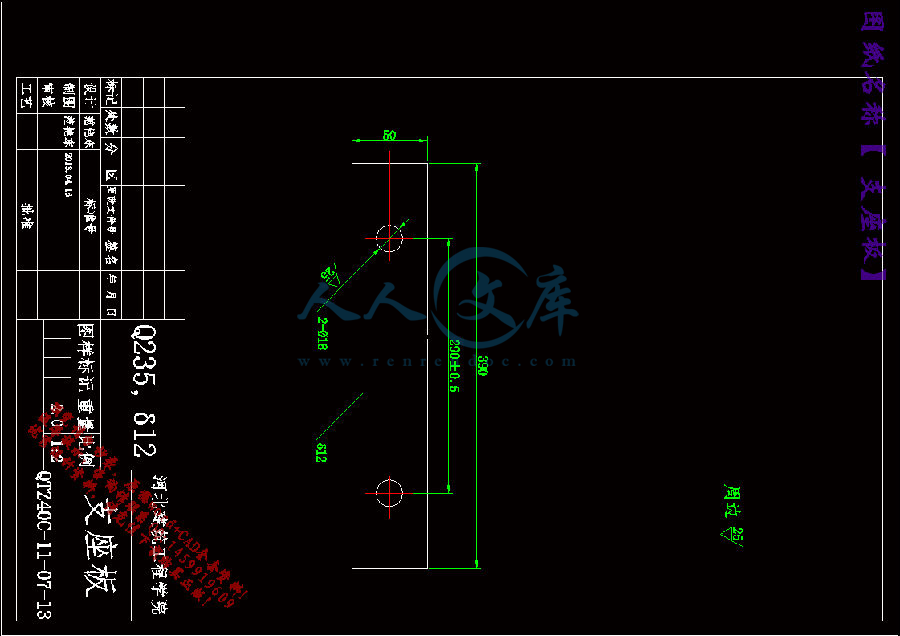

 川公网安备: 51019002004831号
川公网安备: 51019002004831号